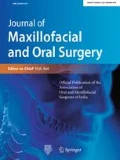Abstract
Purpose
The aim of this present article was to know the efficacy of bone mapping/sketching in management of anterior table frontal sinus fracture.
Material and methods
This prospective clinical study includes 10 patients who reported to department of dentistry, AIIMS Bhopal with anterior table frontal sinus fracture. Sterile plain white paper or a glove cover was used for mapping/sketching. The patients were evaluated for post-operative contour of the fractured frontal sinus defect and any mucocele formation.
Results
All the 10 patients had no infection or post-operative mucocele formation and all have excellent aesthetic of the anterior table of the frontal sinus.
Conclusion
Bone mapping/sketching should be done in all comminuted fractures of cranio-maxillofacial region.
Similar content being viewed by others
Introduction
In only 5–15 % of cranio-maxillofacial injuries the frontal sinus fracture occurs, out of which the percentage of isolated anterior table fractures was 33 % [1]. Due to better understanding of frontal sinus fracture management and expertise development in endoscopic sinus surgery, the management has become much more conservative [2]. The endoscopic fracture reduction according to some surgeons is technically challenging [3]. Displacement, contour defect and comminuted anterior table warrant reduction and stabilization of these fracture fragments. We recommended the use of bone fragment mapping/sketching to arrange the comminuted bone fragments for better management.
In the comminuted fracture of frontal sinus (Fig. 1), it is mandatory to clean and debride the frontal sinus. The complete removal of sinus lining is to be done, to avoid post operative mucocele formation. To regain excellent post operative contour each depressed fracture fragment (Fig. 2) is to be placed at the original position.
To do so a number should be given to each fracture fragment and the fragments should be kept over that particular number to avoid mismatch. The bone mapping or sketching is to be done on plane paper (Fig. 3). We usually use glove cover and a sterile skin marking pen for this purpose.
After proper curettage of sinus lining and debridement, the fracture fragments are placed over the defect followed by fixation (Fig. 4). This helps in excellent post operative contour of the frontal sinus defect.
Advantages
-
1.
Inexpensive
-
2.
Requires less time
-
3.
No expertise required
Discussion
The aim of this article was to present a technique of bone mapping in the management of anterior table frontal sinus fracture, which has not been documented in the literature till date.
Although many authors used similar techniques in management of other fractures, Armitage et al. [4] used three dimensional computed tomography models to create a scapular fracture map. Carsten et al. [5] used a software platform and mapping to reduce the fracture pre operatively with the help of pre operative multimodal computed tomography (CT) data and transferred it to surgical navigation in the management of orbitozygomatic complex fracture management.
Sindwani [6] used virtual endoscopy for mapping the frontal sinus ostia, but the technique is time consuming and endoscopes are expensive. Schmitz et al. [7] used perimeter marking technique for rigid fixation of frontal sinus fracture. Hershman et al. [8] advocated 3 D virtual planning by medical modeling involving preoperative CT and virtual outlining of the boundaries of the frontal sinus confines in management of frontal sinus fracture. On the other hand the present technique requires a plane white paper and can be done in minutes.
Conclusion
To achieve excellent results, we routinely use the bone mapping/sketching in the management of comminuted frontal sinus fracture management. A similar technique can be used in the management of other comminuted maxillofacial fractures also.
References
Strong EB, Sykes JM (2002) Frontal sinus and nasoorbitoethmoid complex fractures. In: Papel ID (ed) Facial plastic reconstructive surgery, 2nd edn. Thieme Medical Publishers, New York, pp 747–758
Kim KS, Kim ES, Hwang JH, Lee SY (2010) Transcutaneous transfrontal approach through a small peri-eyebrow incision for the reduction of closed anterior table frontal sinus fractures. J Plast Reconstr Aesthet Surg 63:763–768
Strong EB, Buchalter GM, Moulthrop TH (2003) Endoscopic repair of isolated anterior table frontal sinus fractures. Arch Facial Plast Surg 5:514–521
Armitage BM et al (2009) Mapping of scapular fractures with three-dimensional computed tomography. J Bone Joint Surg Am 91:2222–2228
Carsten W et al (2006) Computer-assisted surgical treatment of orbitozygomatic fractures. J Craniofac Surg 17:837–842
Sindwani R (2013) Mapping the frontal sinus ostia using virtual endoscopy. In: Sindwani R (ed) Year book of otolaryngology-head and neck surgery, 2013 edn. Elsevier, Mosby, p 206
Schmitz JP, Lemke RR, Smith B (1994) The perimeter marking technique for rigid fixation of frontal sinus fractures: procedure and report of cases. J Oral Maxillofac Surg 52:1120–1125
Hershman G, Katikaneni R, Hirsch DL (2012) Poster 70: use of 3D virtual planning in management of frontal sinus fractures: NYU experience. J Oral Maxillofac Surg 70:e84
Author information
Authors and Affiliations
Corresponding author
Ethics declarations
Conflict of interest
The authors Anshul Rai, Adesh Shrivastava and Manal M Khan declare that they have no conflict of interest.
Ethical Approval
All procedures performed in studies involving human participants were in accordance with the ethical standards of the institutional and/or national research committee and with the 1964 Helsinki declaration and its later amendments or comparable ethical standards.
Informed Consent
Informed consent was obtained from all individual participants included in the study.
Rights and permissions
About this article
Cite this article
Rai, A., Shrivastava, A. & Khan, M.M. “Bone Mapping/Sketching” in Management of Anterior Table Frontal Sinus Fracture. J. Maxillofac. Oral Surg. 16, 127–130 (2017). https://doi.org/10.1007/s12663-016-0917-3
Received:
Accepted:
Published:
Issue Date:
DOI: https://doi.org/10.1007/s12663-016-0917-3








